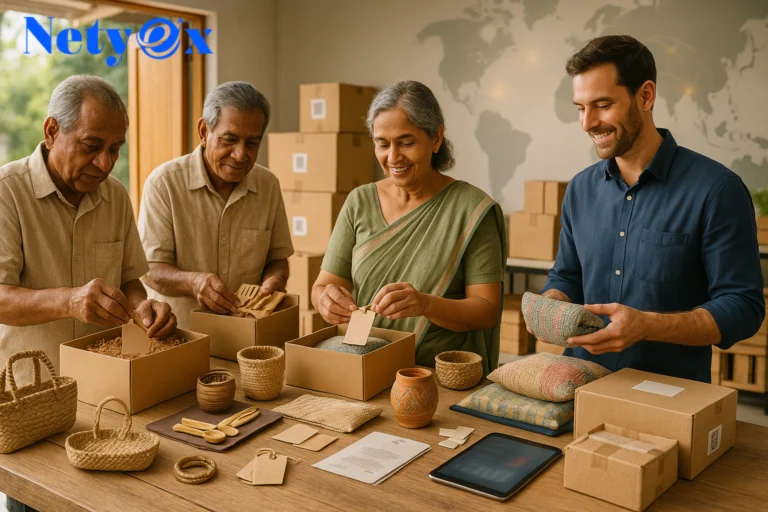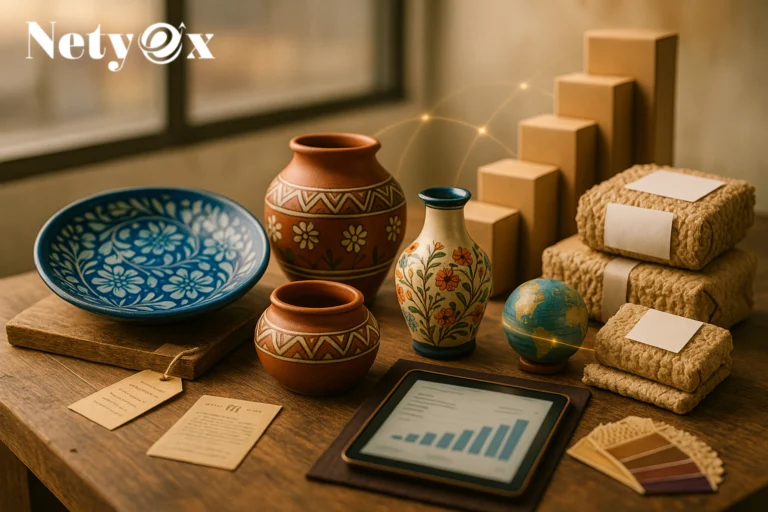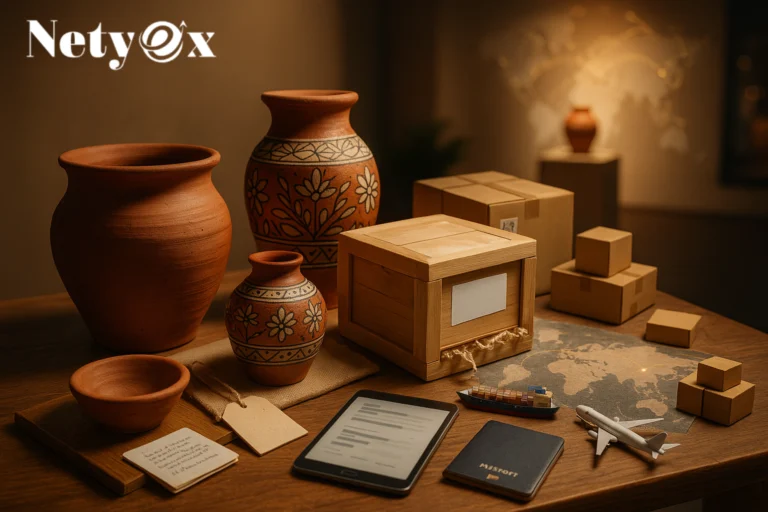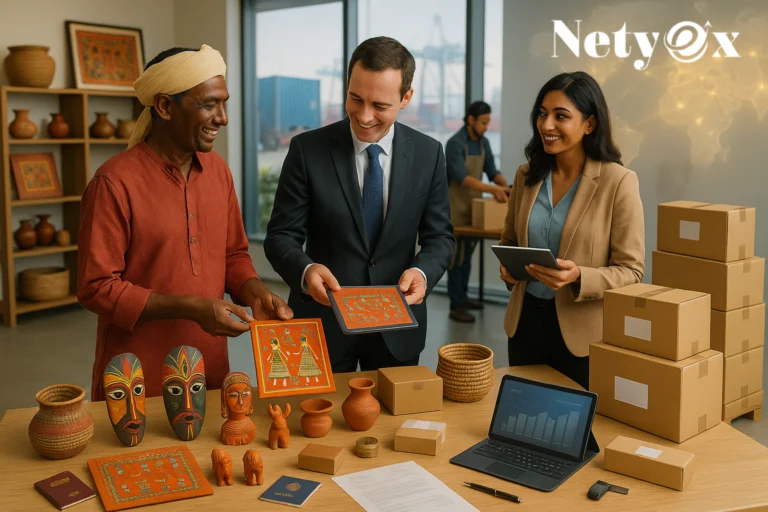Introduction to Handicraft Export Business
Handicrafts have always been more than just decorative pieces—they represent culture, tradition, and identity. With globalization and the rising interest in sustainable and handmade products, the handicraft industry has gained new life on the international stage. Entrepreneurs, artisans, and exporters who want to succeed in this sector need more than just beautiful products—they need a strong brand identity that resonates with global buyers.
Building a handicraft export brand isn’t about selling items randomly across borders. Instead, it’s about creating a recognizable, trustworthy, and scalable identity that highlights craftsmanship, authenticity, and cultural heritage. This article walks you step by step through the strategies and practices needed to build a successful export brand in the handicraft industry.
Understanding the Global Handicraft Market
Current Trends in Handicraft Exports
The global handicraft market has been experiencing rapid growth, driven by rising demand for sustainable and eco-friendly products. According to industry reports, buyers from North America, Europe, and Asia-Pacific are increasingly seeking handmade, eco-conscious, and ethically sourced products.
Minimalist designs, eco-friendly materials like bamboo and jute, and artisanal home décor are trending. Additionally, there’s growing demand for products that tell a story of culture and tradition.
Key Buyer Regions and Consumer Preferences
- North America: Focuses on eco-friendly and minimalist handicrafts.
- Europe: Values traditional craftsmanship with sustainable sourcing.
- Middle East: Prefers luxurious, intricate designs.
- Asia-Pacific: Interested in affordable yet authentic handmade items.
Exporters must study these regions and tailor their product offerings to match consumer demand while preserving authenticity.
Why Branding Matters in Handicraft Exports
Difference Between Selling and Branding
Selling a handicraft may bring a one-time profit. However, branding ensures repeat buyers, long-term relationships, and higher recognition. A strong brand makes your handicrafts stand out in crowded marketplaces like Etsy, Amazon Handmade, and international trade fairs.
Building Trust and Authority in Global Markets
Global buyers often fear counterfeit or low-quality goods. By creating a consistent and reliable brand image, you build trust. This is why branding is not just optional—it’s the backbone of success in the export business.
Steps to Build a Handicraft Export Brand
Step 1: Identifying Your Niche in Handicrafts
Not all handicrafts appeal to all markets. Focus on a specific niche—such as eco-friendly bags, tribal jewelry, or handmade ceramics. Niche specialization helps in creating a strong brand identity.
Step 2: Crafting a Unique Brand Identity
Logo, Packaging, and Storytelling
A memorable logo, eco-friendly packaging, and authentic storytelling make your brand attractive. Buyers love to hear the “story behind the product”—whether it’s about local artisans, cultural heritage, or sustainable materials.
Highlighting Cultural Heritage and Sustainability
Global buyers are increasingly attracted to brands that emphasize ethical sourcing, eco-conscious production, and cultural preservation. Make these aspects central to your brand story.
Step 3: Ensuring Product Quality and Consistency
Quality is non-negotiable. Even one defective item can damage your reputation abroad. Develop quality control processes and maintain consistency across every product.
Step 4: Registering Your Brand and Protecting IP
Register your brand name, trademark your logo, and protect your designs from imitation. This step is crucial to safeguard your business from competitors.
Step 5: Pricing Strategy for Global Competitiveness
Balance between affordability and profitability. While handmade items demand premium pricing, ensure your products are still competitive in international markets.
Marketing Strategies for Handicraft Export Brands
Leveraging E-commerce Platforms and Marketplaces
The rise of digital commerce has made it easier than ever for handicraft exporters to reach global buyers. Platforms like Etsy, Amazon Handmade, eBay, and Shopify allow artisans to display their products directly to international customers without heavy upfront investment. Exporters can also partner with specialized B2B portals such as Alibaba, Global Sources, and IndiaMART to target wholesale buyers.
The key to success on these platforms is professional product photography, compelling descriptions, and strong branding consistency across listings.
Role of Social Media and Influencer Marketing
Social media platforms like Instagram, Pinterest, and TikTok are visual-first, making them ideal for handicraft promotion. Sharing behind-the-scenes videos of artisans at work, storytelling reels, and user-generated content helps build emotional connections with buyers.
Collaborating with influencers who promote sustainable and cultural products can give your brand instant credibility and expand your reach to global audiences.
Attending Trade Fairs and International Exhibitions
Despite the digital boom, physical trade fairs remain vital. Exhibitions like Ambiente (Germany), IHGF Delhi Fair (India), and Maison&Objet (France) attract international buyers who are specifically seeking handicrafts.
Exhibiting at these events not only provides exposure but also builds trust and authority, especially for newer brands.
Creating Engaging Catalogs and Brochures
High-quality digital catalogs and brochures with product details, pricing, and artisan stories can help convince buyers. Having print versions ready for trade fairs also adds professionalism.
Export Documentation and Compliance
Mandatory Certifications and Quality Checks
International trade requires compliance with quality and safety standards. Depending on your target market, certifications like Fair Trade, ISO, or Eco-Cert can enhance credibility. These certifications signal that your products are ethically produced, safe, and sustainable.
Understanding Export-Import Laws and Tariffs
Exporters must familiarize themselves with:
- HS codes (Harmonized System codes for product classification)
- Import tariffs and duties of target countries
- Customs documentation such as commercial invoices, packing lists, and certificates of origin
Failure to comply with these can lead to shipment delays, fines, or rejection at customs.
Building Distribution and Logistics Networks
Choosing Reliable Shipping Partners
For handicrafts, safe packaging and reliable shipping are critical. Partner with international couriers like DHL, FedEx, and UPS, or freight forwarders for bulk shipments. Offering multiple shipping options—express and economy—helps cater to different buyer needs.
Warehouse and Fulfillment Solutions
To reduce shipping costs and delivery time, consider using warehousing solutions in key markets. Fulfillment centers like Amazon FBA (Fulfilled by Amazon) allow exporters to store products abroad and ship them directly to customers with faster turnaround times.
Digital Branding for Handicraft Exporters
Importance of a Professional Website
Your website is your digital storefront. It should include:
- High-quality product images
- Artisan stories and cultural narratives
- Secure payment options
- Contact details for B2B buyers
A professional website builds credibility and serves as a central hub for your brand.
SEO, Content Marketing, and Blogging
To attract international buyers, invest in search engine optimization (SEO). Write blogs on topics like “Sustainable Handicrafts” or “Cultural Heritage in Modern Homes” to establish thought leadership. This drives organic traffic to your website and increases visibility.
Email Marketing for B2B Clients
Building a strong B2B email list is essential. Sending personalized newsletters, product launches, and seasonal offers helps maintain long-term relationships with wholesale buyers.
Case Studies of Successful Handicraft Export Brands
Example from India
Fabindia, one of India’s largest handicraft brands, built its reputation by highlighting artisan stories, traditional techniques, and sustainable sourcing. It started as a small export company and today operates both globally and domestically with a strong identity rooted in authenticity.
Example from Africa
Brands like SOKO Kenya have created global demand by showcasing jewelry made by local artisans. Their focus on ethical trade, women empowerment, and fair wages has positioned them as a recognized international brand.
Challenges in Building a Handicraft Export Brand
Competition from Mass-Produced Goods
One of the biggest hurdles is competing with machine-made, low-cost alternatives. The solution lies in emphasizing authenticity, uniqueness, and sustainability—aspects that machines can’t replicate.
Maintaining Authenticity While Scaling
As demand grows, there’s pressure to scale production. However, scaling without losing authenticity and handmade essence is challenging. Partnering with artisan cooperatives and investing in artisan training ensures consistent quality at higher volumes.
FAQs on Handicraft Export Branding
Q1. How much investment is needed to start a handicraft export brand?
A small-scale export business can start with as little as $5,000–$10,000, depending on product type and target markets.
Q2. Which countries are the best markets for handicraft exports?
The USA, UK, Germany, UAE, and Japan are among the top importers of handicrafts.
Q3. Do I need certifications to export handicrafts?
Not always, but certifications like Fair Trade, Eco-Cert, and ISO can enhance buyer trust and open doors to premium markets.
Q4. What’s the best way to find international buyers?
Use B2B platforms, trade fairs, e-commerce websites, and social media marketing to connect with global buyers.
Q5. How can I protect my handicraft designs from being copied?
Register your brand, trademark your logo, and consider design patents where applicable.
Q6. What is the most effective online marketing strategy for handicrafts?
A mix of SEO, Instagram marketing, and influencer collaborations works best for both visibility and engagement.
Conclusion: The Future of Handicraft Export Branding
The handicraft export industry is evolving rapidly, fueled by consumer interest in sustainability, authenticity, and cultural heritage. To stand out, exporters must go beyond selling products—they must build a brand that resonates with global buyers.
By combining authentic storytelling, digital marketing, quality assurance, and compliance with international trade standards, entrepreneurs can create brands that not only thrive but also preserve cultural traditions for future generations.
The future of handicraft exports belongs to those who can balance heritage with modern branding. If done right, your handicraft export brand can become a global success story.













